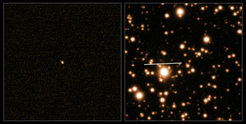VLT spies Rosetta’s comet
From a distance of 500 million kilometers the target comet of the Rosetta mission can already be seen in images obtained by the Very Large Telescope.
ESA's Rosetta spacecraft is scheduled to wake up today after more than 30 months in deep space hibernation. Already, an image obtained on 5. October 2013 from a distance of approximately 500 million kilometers by researchers from the Max Planck Institute for Solar System Research (MPS) in Germany with the help of the European Southern Observatory's Very Large Telescope (VLT) shows the mission's final destination: the comet 67P/Churyumov-Gerasimenko. The image is the most recent observation of the comet before it passed behind the Sun and out of view from Earth's perspective. In order to make the 4-kilometer diameter comet visible, careful image processing was necessary.

The starting point for the current image is a long series of observations performed on 5. October 2013. In their data processing, the researchers reveal both the comet without the background stars (Figure 1, left) and the star field with the track of the comet marked (Figure 1, right). At the time of the observations, Churyumov-Gerasimenko could only be viewed from Earth against a crowded star field towards the centre of the Milky Way, and was impossible to separate from the starry background in individual observations.
Dr. Colin Snodgrass, who processed the data, describes the technique: "To produce this image of the comet I applied a technique called difference image analysis, which carefully corrects for the subtle changes in the appearance of the stars in each image due to movement of Earth's atmosphere above the telescope. This trick removes everything which is 'fixed' in the sky, and leaves only stars which change in brightness, or objects that move, like the comet."
On 5. October 2013, the comet was still so far from the Sun that its icy nucleus was not releasing any gas or dust, and appears as a simple spot. Even with the world's largest telescopes, the nucleus is too small to be resolved. As it approaches the Sun, its surface will heat up and its ices will sublimate, dragging dust out to form a tail.
Already in August 2013, researchers under the lead of the MPS had analyzed numerous images of the comet, some of them dating several years back. They expect that Churyumov-Gerasimenko may already become active this year in March. They will be keen to check in on the comet again in February, when it is next observable by the VLT, and much closer to the Sun.
The observation released today marks the start of a close collaboration between European Space Agency (ESA) and the European Southern Observatory (ESO) to monitor the comet from the ground during Rosetta's encounter with 67P/Churyumov-Gerasimenko later this year. MPS scientists will use the ESO-images to compare the overall activity of the comet with the detailed data returned by Rosetta's instruments. The MPS is home to the Principal Investigators of three of Rosetta’s instruments: the scientific camera system OSIRIS (Orbiter), the secondary ion mass spectrometer COSIMA (Orbiter), and the gas analyzer COSAC (Philae). In addition, the MPS has contributed to the five other instruments ROSINA, MIRO, CONSERT, DIM, and ROMAP and has developed and built important parts of the lander Philae.
Comet Churyumov-Gerasimenko is on a 6.5-year orbit around the Sun and is currently out towards the orbit of Jupiter. It will be closest to the Sun — roughly between the orbits of Earth and Mars — in August 2015.
